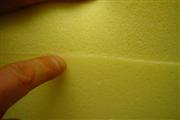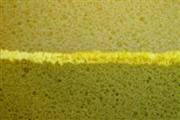The gluing process
of memory foam mattresses
As I deal with and supply a large amount of beds to the health care sector, it is very important that our beds are correctly ventilated and that they do not become damp/wet with 24 hour use. We use a totally open cell structure and glue these together in a natural way (water based glue). The advantage of gluing with water based glue in comparison with synthetic glue is that water based glue will only stitch/bind to the cell corners; because of this you don’t close the cell structure and it keeps the material’s ability to breathe and moisture can seap between the two foams (cold foam/memory foam) easily.
What is promised and what is delivered can differ greatly in this industry. In our showroom we have lots of different mattresses from colleagues for our customers to compare. We order them for us to know how they are made and what they are made from while at the same time allowing the customer to be able to really compare all the memory foams available. To our surprise we came to discover that at least three suppliers do not deliver what they promise to. On one occasion it said on their website and on their mattress that they deliver a cold foam HR45 when they actually deliver a poleyther SG35. Please note that polyether is 9 times cheaper than cold foam!
But there are exceptions like Tempur, Hypnos and of course RHF that do deliver what they promise.
Below you can see an example of cold foam and polyether foam: polyether clearly has a small cell size when compared to cold foam and the cold foam cell structure has many different cell sizes in contrast to polyether where all the cells are the same size.
 |
|
Foam layers glued correctly. |
Foam layers glued badly, to thick layer of glue so ventilation becomes a problem. |

